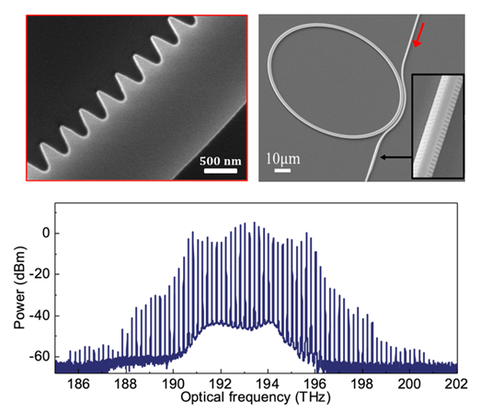Summary
We are developing advanced-packaging techniques to combine photonics and electronics in support of continued scaling in digital systems. Our research focuses on generation of frequency-comb lasers with integrated photonics for emerging high-speed data communication, advanced computing architectures, and signal generation across the entire microwave, millimeter wave, and terahertz bands. Combining photonics and electronics leverages the immense scalability of digital computing with the extreme bandwidth and coherence of optical signals. Energy consumption is a key performance driver in scaling data center interconnects, distributed computing architectures, and high-performance computing applications like AI. Our team’s research on efficiency and system integration in multi-wavelength microresonator frequency comb laser processed on semiconductor wafers opens new opportunities for extreme information capacity.
Description
Using integrated photonics, we generate spectrally flat, dark soliton microresonator frequency combs with accurate alignment to the ITU-T grid. These laser sources support innovation in advanced communication and computation applications. Moreover, technical development in these application areas offers unique opportunities to open-up new physical effects for converting laser light with nonlinear photonics. Our microcombs offer high coherence, low power consumption, and high pump-to-comb conversion efficiency. We demonstrate a 200 GHz soliton microcomb spanning from L-band to S-band and the mismatch (distance between each comb line and the closet ITU-T channel) is below 4.6 GHz. In these microcombs, we achieve close to 70% pump-to-comb conversion efficiency with 40 mW on-chip pump power. Our approach opens a path towards practical application of microcombs in high-speed optical interconnects.

Through the DARPA PIPES program, we are developing ultrahigh speed optical links with microcombs and semiconductor-foundry-based silicon photonics and electronics systems. The rapid growth of data traffic in optical communication networks requires more compact and more power efficient wavelength-division multiplexing (WDM) transceivers with larger data capacity. Microcombs have merged as a promising candidate for chip-scale light sources in WDM systems. Compared with conventional laser array solutions, microcombs offer revolutionary advantages, such as small footprint, low power consumption and high-power efficiency. Our microcombs are used with monolithically integrated silicon photonics and electronics circuits that implement a 1 Tb per second optical link. Monolithic integration of photonic devices with CMOS electronics significantly reduces the packaging complexity and enables operation at ultralow power consumption. This work explores next-generation photonic-electronic system integration that supports extreme data capacity and can be extended to computation applications, high-speed microwave and millimeter-wave signaling, and sensing of various physical observables.

Publications
[1] K. Y. Yang et al., Multi-Dimensional Data Transmission Using Inverse-Designed Silicon Photonics and Microcombs, Nat Commun 13, 1 (2022).
[2] C. Shirpurkar et al., Photonic Crystal Resonators for Inverse-Designed Multi-Dimensional Optical Interconnects, Opt. Lett., OL 47, 3063 (2022).
[3] G. M. Brodnik, M. W. Harrington, J. H. Dallyn, D. Bose, W. Zhang, L. Stern, P. A. Morton, R. O. Behunin, S. B. Papp, and D. J. Blumenthal, Optically Synchronized Fibre Links Using Spectrally Pure Chip-Scale Lasers, Nat. Photon. 15, 588 (2021).
[4] J. Zang, T. C. Briles, J. S. Morgan, S.-P. Yu, A. Beling, and S. Papp, Soliton Microcomb-Based Millimeter-Wave Synthesizer, in 2019 IEEE Avionics and Vehicle Fiber-Optics and Photonics Conference (AVFOP) (2019), pp. 1–2.
[5] S. B. Papp and J. Zang, Millimeter-Wave Frequency Synthesizer Based on Microcomb Photomixing, and Associated Methods, US11336377B1 (17 May 2022).
[6] R. Bustos-Ramirez et al., Synchronization of Electro-Optically Modulated Kerr Soliton to a Chip-Scale Mode-Locked Laser PIC via Regenerative Harmonic Injection Locking, Journal of Lightwave Technology 40, 1742 (2022).
Major Accomplishments
- Demonstration of microresonator frequency combs with greater than 70% efficiency for wavelength-division multiplexing applications.
- Carried out collaboration experiments through the DARPA PIPES program to explore use of microcombs for Terabit per second optical links.

